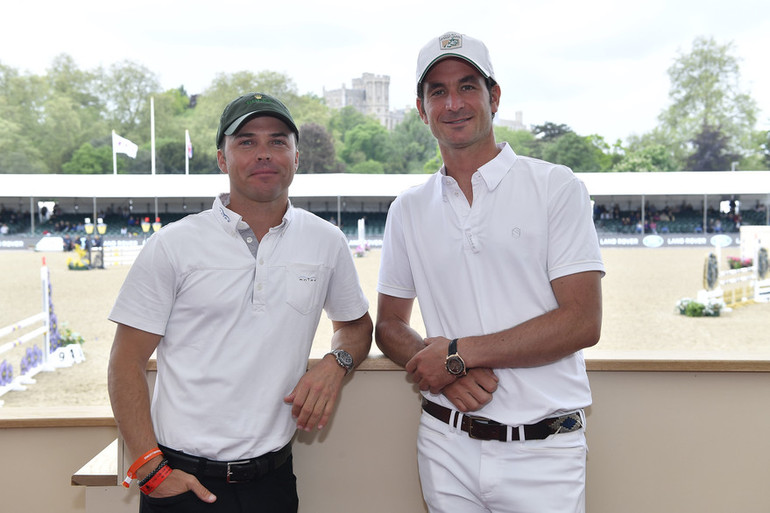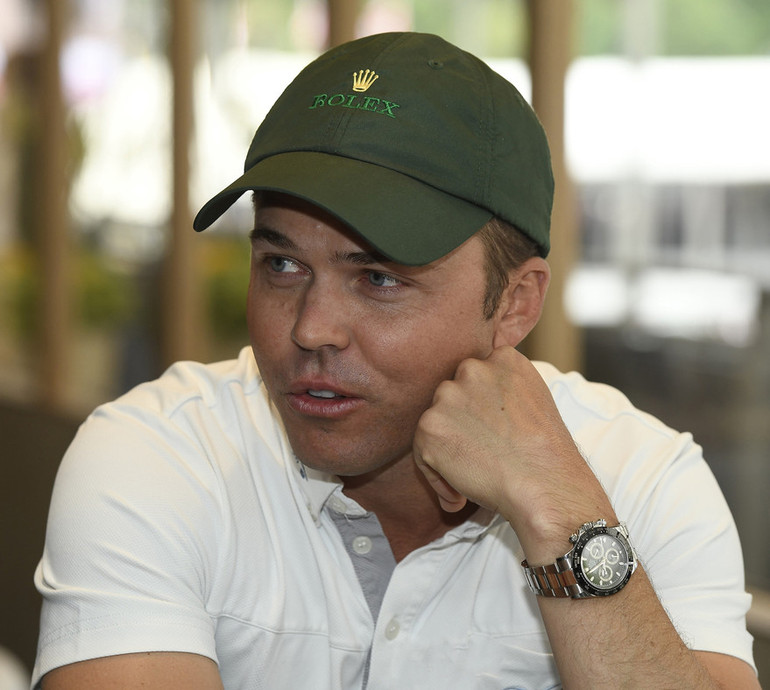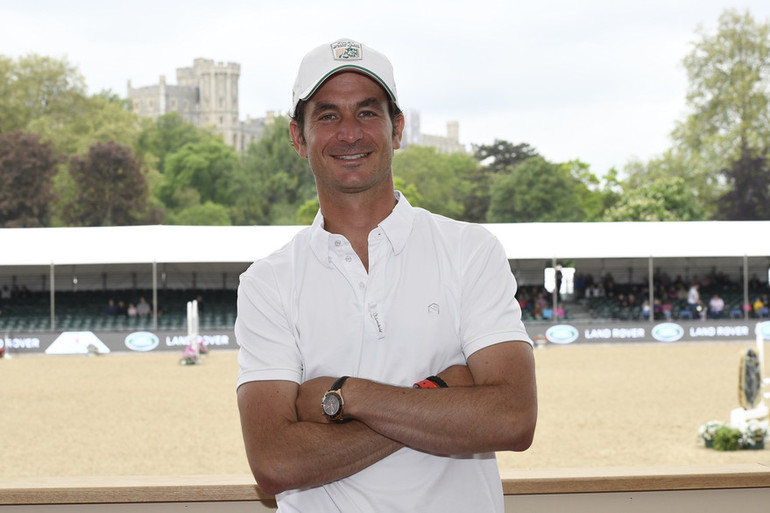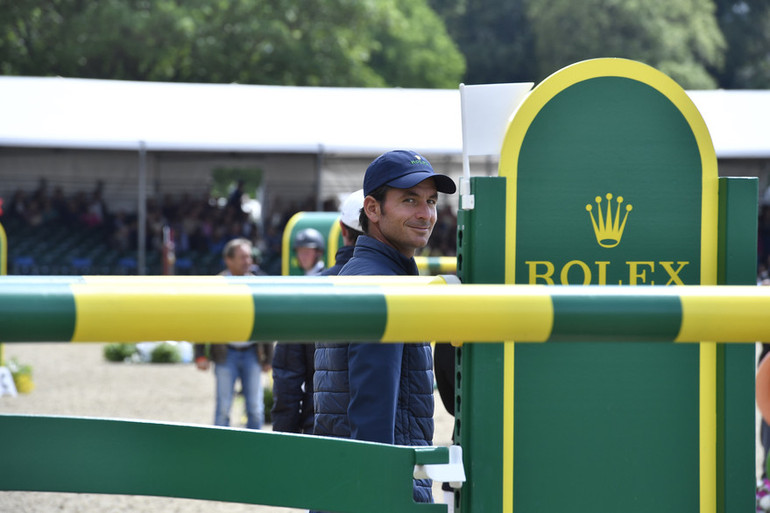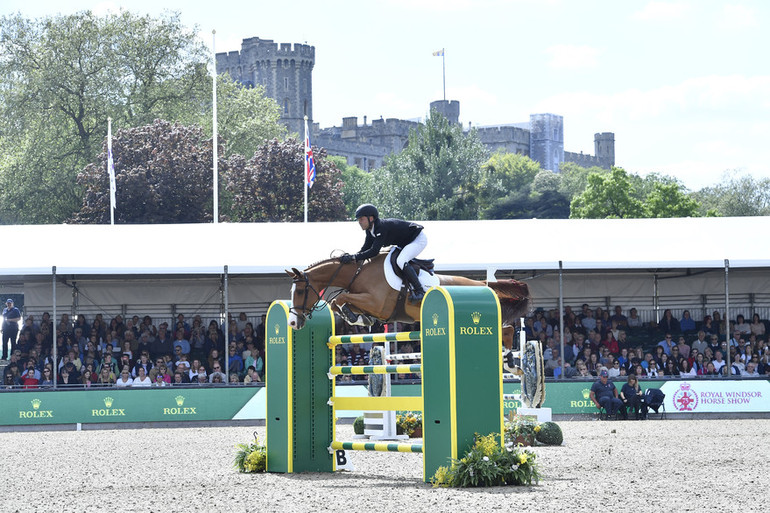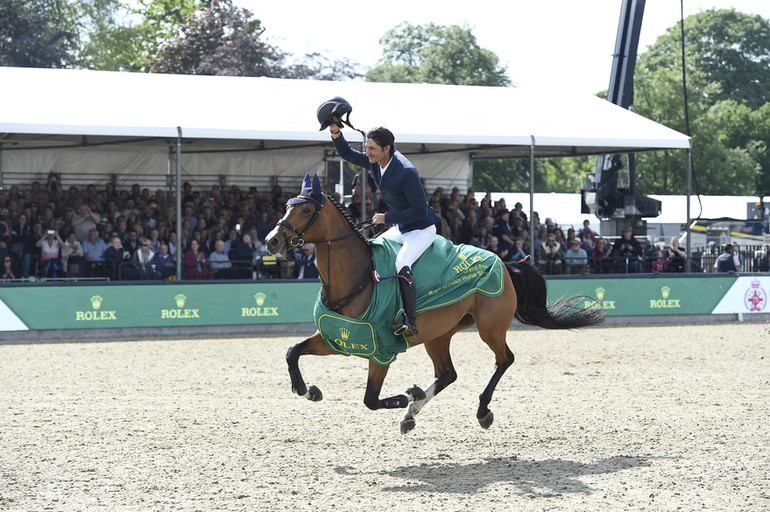By Esther Hahn
Seated in the Rolex private viewing booth at the Royal Windsor Horse Show CSI5* on Saturday morning, Switzerland’s Steve Guerdat and the United States’ Kent Farrington are prepared to speak on all things show jumping with a handful of journalists. An impressive breakfast spread is laid out for all to enjoy, but all present opt for tea and coffee, eager to dig into the sport’s top resources on hand.
Farrington is newly back to competition after sustaining a serious leg break just three months before. And for Guerdat, it’s only his second appearance at the heritage, British show since his first visit in 2009 when the Swiss team won gold at the European Championships. After missing out on the stop in the past few years, he made sure to include it in his schedule, especially once he heard repeatedly from other riders just how good the show was produced, Guerdat says.
And he wouldn’t be disappointed: following the round table, Guerdat would go on to win the headlining event, the Rolex Grand Prix of Windsor, the next day, with the horse he refers to as his “best horse,” Bianca. Farrington would also record a good show, delivering solid performances to prove his readiness to be back at the top, including a third-place finish in Saturday’s King’s Cup, aboard Creedance.
So with computers at the ready and pens poised, the discussion begins. Here’s everything to know from two of the world’s top ten riders in show jumping:
An early start
“Well, it was quite natural for me [to get into the sport] because my father was a rider,” says Guerdat about his early days with horses. “We had an apartment in the stable. It’s basically like when other people play football in the garden, we had horses in the garden so you get started. I guess most of the kids like animals. We like first playing with animals and then they put us on them."
“The feeling to the horse came straight away. I always liked that. I liked a lot of sport in my young age, but at some point, I decided that show jumping was what I liked the most. Then I went step by step from junior to young riders to making it to the first team."
“I think I was lucky to have a family [with experience in the sport]—especially a father who was already in that lifestyle—so it was of course easier for me to get started. It was an important advantage at the start of my career and possibly also why I could have good success at an early age.”
“My story is completely the opposite,” Farrington says, to juxtapose his experience with Guerdat’s. “I grew up in the city of Chicago, and I started riding at a carriage stable. I originally wanted to be race jockey, and I did some pony racing."
“I was kind of discovered at a George Morris clinic outside of Chicago. He gave me my first opportunities and sponsored me with some horses. He got me to Wellington, Florida, which is our big tour in the winter, and it kind of built from there."
“It’s sort of the same as Steve in that riding opportunities came. A lot of industry professional sponsored me with horses, and I catch rode a lot of horses. I did the young riders and the grand prix classes. I worked for a couple top pros and went out on my own when I was 21.”
In a side note, Farrington reveals that his record for the number of ponies he rode in one day is 26. “I took some tumbles, too,” he adds, with a laugh.
“In the beginning, it was more frustration and pain,” Farrington says about his injury in which both his tibia and fibula were broken. “I was down immediately. It was like being shot in the leg—I couldn’t move."
“But from the very beginning, I was determined to move so right after the surgery I couldn’t sit still. I had to get up so they gave me some crutches and I was limping around the hospital at night."
“From there it was just the process. I had very good doctors and physical trainer. I would train two, three times per day, every day, at the gym and at home. I would do physio then they would x-ray to make sure I wasn’t laying down too much bone because you can over train. It’s a balance between enough concussion to build bone but not too much to build too much bone. It was alternating the type of training I was doing depending on how my body was responding so it was a long process of how much pain is tolerable? How much is good pain and how much is too much pain where you’re going to hurt yourself and you have to stop? It was a strong mental exercise."
“I’m an aggressive person so I don’t want to sit around. I was just determined to go again. I didn’t really want this to slow me down more than necessary. I would say there is a little discomfort [when I’m riding]. My leg doesn’t feel quite at 100 percent, but it’s manageable. So that’s where I go, ‘Can I manage or not manage it?’"
“I’d say when you step away from anything you come back with a better appreciation for it. Riding these horses, I really appreciate how exceptional some of the horses are that I get to ride. You start jumping them and think, ‘Wow, this is an amazing horse.’ You get used to riding because you do it all the time. I would say [I came back with] an appreciation for how good the horses are and how fortunate I am to have that kind of backing and those kinds of horses in my stable."
“Constant repetition [helped to build confidence in the strength of the leg]. It’s difficult in that you have to understand that there’s going to be a certain amount of pain and discomfort, and you just get comfortable with it being like that. And then it gets a little bit better and a little bit better. But I think most athletes are accustomed to pushing the limit of things and being comfortable with being uncomfortable. It’s not going to be perfect, and you manage anyway, and you keep going and that makes you stronger. I think it’s an experience every athlete shares across most sports."
“I kept my horses in the same training as usual—a little bit lighter obviously because I wasn’t out competing. I have a great rider at home, Claudio Baroni. He’s been with me for a few years. He’s a fantastic flat rider and a very good jumping rider, but he just doesn’t want to show so we worked out a schedule of keeping the horses fit. As soon as I was ready to go, the horses were ready to go also.”
On pursuing no. 1
“That’s not really something that we chase,” Farrington says of the top position in the world rankings. “In horse sport, it’s about managing the horses that you have and trying to have them be at their best. So no. 1 is the best schedule for the horses, and the results are a consequence of all of those things combined. I always say I would rather have a good schedule and help the horses win five grands prix a year and be no. 2 than I would to be 2nd 20 times and be hard on my horses and be no. 1. It’s not about chasing no. 1 for me, it’s about getting back to doing the sport like I was before and let it play out how it plays out.”
“I always say that we lose a lot more than we win,” says Farrington. “It’s understanding and building a mental tolerance for when things don’t go well and trying to keep fighting to having it go well. And know that a majority of the time, it’s not going to go the way you want. The best riders and the best horses in the world win less than 20 percent of the time. That’s a high percentage of things going wrong."
“I try not to change anything before competing. We put so much pressure on ourselves, we don’t need any extra pressure to get in the zone. We have to probably relax more than anything else and try to treat it like any other round, any other day. That’s more likely to produce a good result than to try to put yourself in some different place. If we do what we normally do, the way we normally do it, that’s our best chance for it to go well."
“I like to keep it super simple: stay relaxed, control the things I can control, which is my set up before I come to the show, that my horses are in top condition, that I’m in as good of condition as I can be, that my horses are qualified to do the event I’m asking them to do, that it’s not over their heads, that they’re healthy and ready to compete. The rest of it, I’m going to leave it on the field.”
“You can’t think that what you’re going to do over the last hour or two hours or even one day or one week before the show is going to bring you the result,” adds Guerdat. “I think it’s about the system and the work you put into your horses day by day and day after day and over the year. For me, the most important thing is that when I get to the show, I’m ready for that show, my horses are ready. We’re fit to go and compete and as long as I know that in the preparation we made everything right, there’s not much you can change in the last few hours or days before it starts."
“I like to do the work right at home so I know we’re ready when we go. Then it’s a competition like we have every week. You can’t win every time but it’s important that I know I did as much as possible to try and make it happen.”
Have goals, will travel
“I am aiming for the World Championships,” says Guerdat. “For sure, it’s very important time of the year. It’s only every four years so it’s an important title. After that we have Aachen, Calgary, and Geneva and these kind of shows are the ones we are really looking forward to. We have a busy schedule with a lot of those nice shows."
“I like to set the main goals for the year and always get like eight to ten shows we really want to aim for and then from that I go backwards to the other shows. I think Bianca, if everything stays the same and good, should be the one [to compete at the Championship].”
“Gazelle is probably my strongest horse at the moment,” Farrington says. “I have some ones that are still competing, but they’re older so I try to be very careful with their schedules. I have some very good young ones coming up, but they probably aren’t quite ready to consistently perform on that kind of level so she’d be the one I’m aiming at the biggest events this year."
“I think even without considering it a consolidation of those events—Aachen, Calgary, Geneva—into the Grand Slam, those are the best shows in the world so we want to do those shows and do well at them anyway. And the Grand Slam is extra motivation to boost all of us to try to be even better. These are all of the places you dreamed of riding at and trying to win.”
Future of the sport
“I have to say, I was very worried a few years ago, like one or two years ago,” says Guerdat in response to the direction in which show jumping appears to be heading. “And I’m more positive now and feeling a little bit better thanks to Rolex because I think they stepped big into the sport. They’re helping the real shows, the ones that we like and the ones that our sport can benefit from and can motivate young people to follow us and do our sport."
“They’re really kind of saving those shows, and if I see myself now without doing any GCT or GCL, I still have a full schedule with a lot of, what I think, even nicer shows. I’m very happy and confident about that so I’m hoping that most of the fellow riders will follow these shows and be part of this growing again from these shows."
“We’re not going to those [Rolex] shows because there’s a Grand Slam bonus or because there’s more money on Sunday—this is not the first motivation for going to those shows. These are the shows we aim for when I say there’s eight or ten shows a year we like to go to—they are basically those shows."
“The atmosphere is nice,” says Guerdat to describe Royal Windsor. “I like when you walk into a show and basically you see horse-friendly people wherever you go. You see kids, you see ponies, you see people that are there for horses, for the sport, whether it’s show jumping, hunting, ponies, or whatever. I think this is what we need."
“At the real shows that I like to go, this is what you see. When you see people in the stands, they are actually watching the class. Many shows, they are looking at what they have on the plate or talking business around the table and maybe by the time of the prize giving, [they wonder] about who won the class. But here, they’re following the sport and they’re here for the horses. This is personally what I really enjoy when I’m walking into a show.”
“What makes the best competitions are the best riders, the best prize money, and a great crowd,” Farrington adds. “You have all of those things here. And as Steve was saying, you have an educated crowd so it’s not just people yelling because a horse goes over a jump. They understand a great turn, they understand when somebody leaves out a stride—they know the difference so that makes it a lot more exciting even to ride because they react to things that they have to understand. They know a great round when they see it. They know top riding when they see it. That’s part of what makes it special here."
“These shows are really for the sport. It’s a proper sized arena where you can have a real grand prix and you can ride. It’s not a circus-size arena. It’s important to have a big enough warm-up to ride and a real arena to compete. That’s more what our sport is about. You have to actually have the space to do our sport.”
Hidden gems
“The most exciting horse in my stable is still Nino but he’s in the field with the ponies,” Guerdat reveals. “He’s still ridden every day. I would be most excited to put a saddle back on him. I have a lot of very nice horses. I’m lucky. I think Bianca is very exciting. Hannah is winning a lot. I have an 8-year-old called Flair who is stepping up and I think is going to be a special horse as well.”
“I’m always hesitant to say because I like them to prove it,” explains Farrington. “We know they’re good when they actually go out there and do it because the rest of it all is speculation. But if I had to say, I have two 9-year-old horses called Baltic Star and Jasper. I think they’re both pretty special and we’ll see where they go. I’ve had Baltic Star since he was 7, and Jasper I got when he was 8.”
“My most memorable Rolex win was my first in Spain,” remembers Farrington. “I promised my sister when we were kids [to win a watch]. She would go around to the shows and help tack up the horses and follow me around carrying my gear—so she made a lot of sacrifices for me—and she said she wanted me to win a watch for her but it had to be a Rolex. She’s got high standards. We set the bar up there. Big pressure from the little sister."
“I won that in Spain and that was really memorable for me because it was a promise I made to her and then to pull it off and give it to her… she still wears it to this day. That’s her favorite watch.”
“The first big win in Geneva with Jalisca [Solier] was very special,” says Guerdat. “It was the first really big win, first World Cup. I was coming back from a new start and coming back with that mare, who was very special for me."
“Also, the two-time winner Nino and our first Grand Slam victory and after that Olympic gold at home was also very special. Then to repeat it two years later again made it special. It’s difficult to choose one. Every victory has something in it to make it special which is why you never get bored of winning.”
Text © World of Showjumping by Esther Hahn
Pictures © Rolex/Kit Houghton
No reproduction without permission



